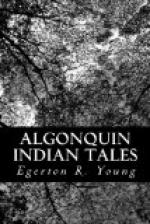Then began the preparation of the feast. Some of the Indians added dry wood to the fire until there was a hot, smokeless blaze. Others took out their sharp hunting knives and cleverly cut up the ducks, rabbits, and partridges. Then these pieces were spitted on the ends of sharp points of hard wood and skillfully broiled or toasted in the hot flames. As fast as the dainty bits of meat were cooked and a little cooled they were given to the children in their fingers, and in that way the little ones had their feast.
Now, please don’t turn up your noses at such a feast. Think of it: out in a wigwam in the lovely forest, where the wild birds sing and the squirrels chatter, where is heard the music of the waves playing on the shore but a few yards away, with great friendly Indians as your waiters! The very air of that northern summer gives you an appetite ready for anything.
Those little people, red and white, soon became the jolliest of friends, and as the white children could speak the Indian language as well as their own they were soon all chattering away most merrily while they daintily picked the bones. Of course this way of eating was hard upon their hands, faces, and clothing, but what healthy child ever gave a second thought—if a first—to any of these things?
After a time this feast, as all feasts must, came to an end. Then the question was, “What shall we do next for the children?” for the whole day had been planned by the grown-up Indians for the entertainment of the little people. Canoes had been collected on the shore of Winnipeg, handy if it should be decided that they all should go for an afternoon outing on the water. However, Souwanas, who had gone out to look at the sky and observe the winds and waves, now came in and reported that he thought they would better put off the canoe trip to some time when the lake was more calm. It was then suggested that the children be asked what would please them most. The little folks, white and red, were not slow in giving their decision.
“Tell us a story about Nanahboozhoo.”
“Who shall be the story-teller?”
There was a hearty call for “Souwanas!”
On coming in from investigating the weather, but a few minutes before, Souwanas had seated himself on a robe and was now enjoying his calumet, or pipe. Stoical though he was, his dark eyes flashed with pleasure at the unanimous call of the children, but, Indianlike, it would have been a great breach of manners if he had let his delight be known. Then, again, Indianlike, it would never have done to have seemed to be in a hurry. The Indian children well knew this, but who ever heard of white children that could sit like statues, grave and dignified, while the story-teller took time to finish smoking a large pipe of tobacco?
So it was in this case. In their wild excitement and eagerness to have the story begin, both Sagastao and Minnehaha sprang up and, rushing toward Souwanas, vied with each other in seeing which could first pluck the half-smoked calumet from his mouth. Such audacity appalled the Indian children and fairly took the breath away from the older Indians. For was not Souwanas a chief, and the calumet almost a sacred thing while between his lips?




